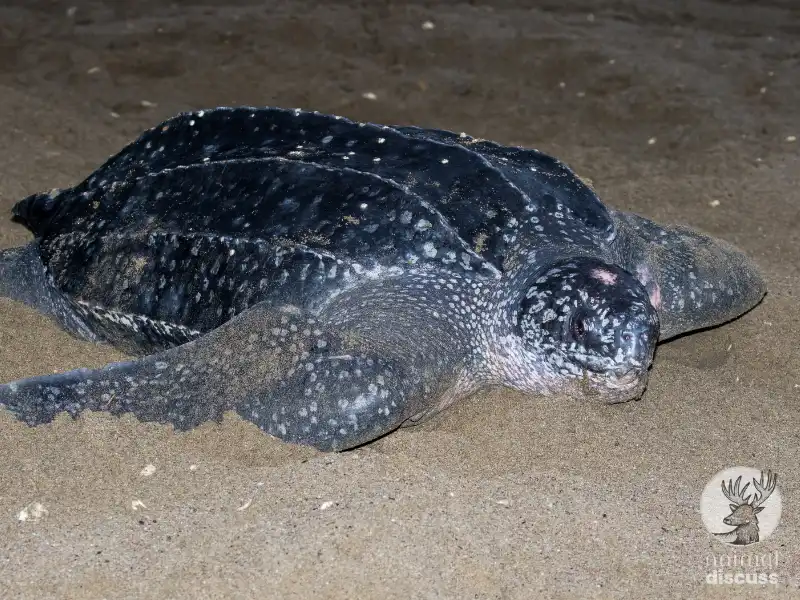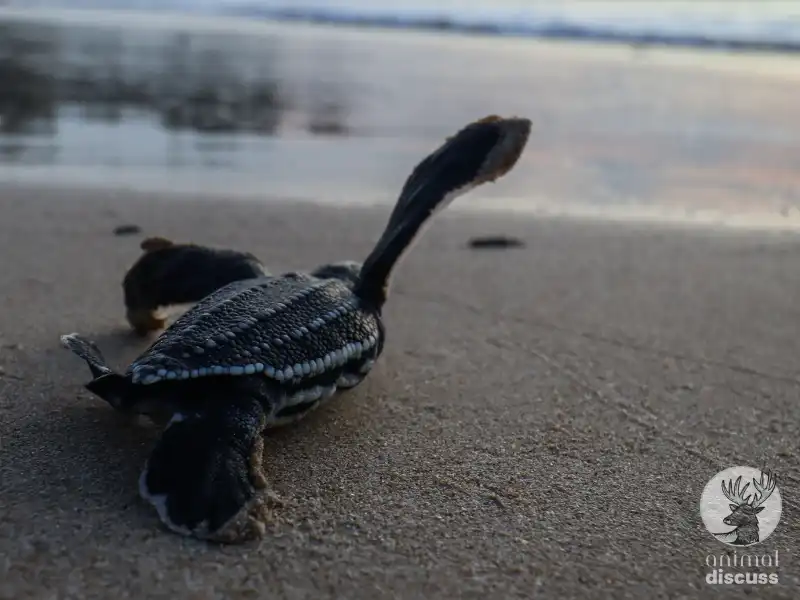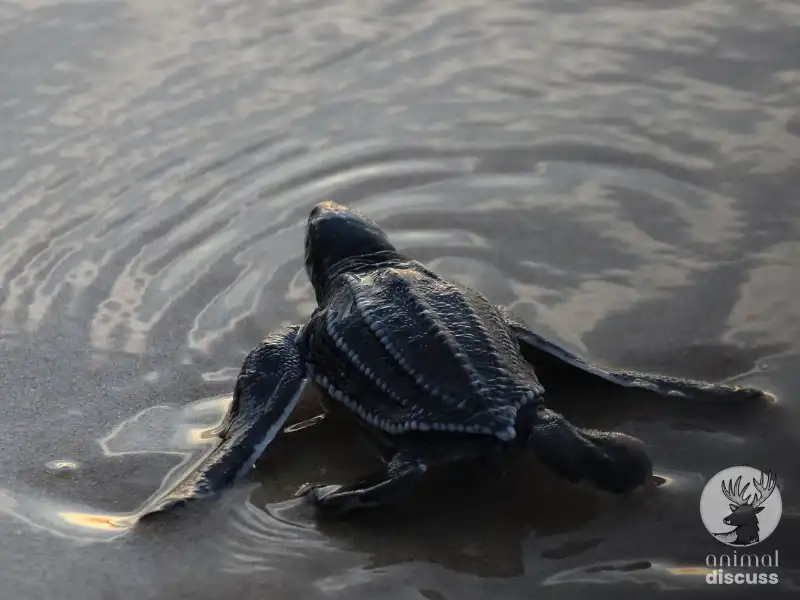Imagine a turtle without a hard shell! Yes, a leatherback sea turtle does not have any hard shell like any other turtle. They have rubbery-like skin and found existence from the age of dinosaurs.
Moreover, this leatherback sea turtle has a hydrodynamic body, and they are the largest turtle and heaviest non-crocodilian reptile. Also, they are the greatest migratory living turtles in this world.
However, their distinguishing feature is carapace which helps them to dive deep in the ocean.
In this blog, you will learn about the unique characteristics, behavioral facts, eating habits, habitats, threats and conservation of leatherback sea turtles.
Keep reading to know in detail.
Characteristics of Leatherback Sea Turtles: What Makes Them Different? [Reference 1] [Reference 2] [Reference 3]
Which features do make a leatherback sea turtle unique? Well, their lack of scales and hard shells makes them unique among other species of sea turtles. On the other hand, they do not have any teeth but have serrated jaws which helps them to munch their fibrous meal.

Besides, the broad, sleek shell and non-retractile head are their distinguishing features. And their limbs are flippers that are designed for swimming. Therefore, leatherbacks are unable to pull their heads and limbs within their shells, unlike other types of turtles.
Due to this physical appearance, they are vulnerable while they are on land. Now have a look at the below table to know facts about this wonderful creature of the ocean.
| Features | Facts |
|---|---|
| Common name | Leatherback Sea Turtle |
| Scientific name | Dermochelys coriacea |
| Type | Reptile |
| Family | Chelonioidea |
| Size | Up to 8.5feet |
| Shape | Teardrop-shaped |
| Average Weight | 300-500 kg Largest found- 900kg |
| Average lifespan | Up to 50 years |
| IUCN red listed | Vulnerable |
| Diet | Carnivore |
| Habitat | Warm and Temperate open ocean |
| Coloration | Dark brown and Green |
| Top speed | 10kmph (6.2 mph) |
| Nesting | Tropical beaches, some nesting in Florida; open beach |
| Predators | Birds, crabs, sharks when juvenile |
| Current Range | Atlantic, Indian, and Pacific Oceans |
| Population | 100,000 females worldwide, males unknown |
What Do Leatherback Sea Turtles Eat? [Reference]
Now, let’s discuss the leatherback sea turtle’s dietary preferences. These amazing animals are well-known for their interest in jellyfish as they are carnivorous.
Jellyfish and other soft-bodied marine invertebrates like salps and tunicates make up the majority of their diet. Their strong jaws and pointed papillae enable them to seize and eat their slippery meal.
Moreover, it’s interesting to mention that because of their special adaptation, leatherback sea turtles can eat a lot of jellyfish. In order to prevent their prey from escaping while eating and drinking, their esophagus is coated with spines that point backward.
Also, their ability to adapt helps maintain the natural balance of marine environments while enabling them to meet their nutritional needs.
To know more about Leatherback Sea Turtle eating habits, have a look at “Explore the Dietary Delights of Leatherback Sea Turtles”.
Where Does a Leatherback Sea Turtle Live? [Reference]
Every ocean in the globe is home to leatherback sea turtles. They cover enormous geographic areas on their travels. These turtles can easily move across a variety of coastal settings because of their extreme adaptability. Also, they are capable of swimming against fast currents.
For instance, they are mostly found in the Atlantic, Pacific, and Indian Oceans. Thus, they are also found in West Africa, Florida, Costa Rica, Colombia, and French Guiana. But they travel to these areas to Alaska and Labrador which is the northern part of the world.

Furthermore, these amazing animals are experts at the art of survival, whether they are found on the sunny beaches of the Caribbean or the freezing waters of the Arctic. At every temperature, they can cope with living.
However, new data from satellite tracking suggests that leatherbacks forage in places that are slightly offshore. The only reptile that has been shown to stay active in water below 40 degrees Fahrenheit.
And the migratory behavior of leatherback sea turtles is one unique feature. They frequently travel hundreds or even thousands of miles during their migrations. Scientists are able to monitor sea turtle movements throughout entire oceans and even between different locations.
For example, numerous leatherbacks have been observed traveling from tropical beaches where they nest to the icy waters of the Arctic and return. Their amazing strength and determination are on exhibit in this breathtaking migration. Thus, their longest migration was 12,774 miles from Indonesia to Oregon.
To know about the details of leatherback sea turtle habitat, have a look at “Unveiling the Habitat of Leatherback Sea Turtles in the Ocean”.
Behavioral Facts of Leatherback Sea Turtles [Reference]
Aside from their physical characteristics, leatherback sea turtles display interesting behavioral qualities. It is well known that these gentle giants are extremely intelligent animals who can learn new habits and solve challenging puzzles.
Even after years of migration, they have a strong homing instinct that allows them to return to their birth beaches to put down their own eggs.
Some major factors of leatherback sea turtles’ behavior are given below:
Reproduction and Nesting Habit
The nesting habits of leatherback sea turtles are amazing when it comes to reproduction. To lay their eggs, female leatherbacks migrate back to their birth beaches.
To protect the future generation, they hide their eggs in deep nests they dig in the sand. Yes, their life cycle depends on this behavior, which also helps to preserve their species.
Nesting Season and Breeding
Leatherback sea turtle’s sexual maturity may come between 9 to 20 years of age. On the other hand, nesting can take place from February to July; females lay 5-7 clutches throughout the nesting season.
However, they lay 30 smaller, unfertilized eggs and an average of 80 fertilized eggs along with the size of billiard balls, in each nest. Over 65 days are spent incubating eggs.
Although they often remain in the same area, female leatherback sea turtles have the ability to switch up their nesting sites in contrast to other species.
Scientific Discoveries on Leatherback Sea Turtles
There are numerous wonderful facts about leatherback sea turtles that have been discovered by science. For example, their capacity to descend to remarkable depths is simply amazing.

These turtles have the ability to dive into more than 4,000 feet in order to find their preferred meal, jellyfish. This breaks down their fundamental defense mechanisms against the intense pressure and frigid temperatures found in the ocean’s depths.
Also, the fact that leatherbacks can keep their body temperature above that of the surrounding water is another wonderful discovery of science. To efficiently store heat and extend their foraging periods in colder waters, they have developed circulatory modifications known as countercurrent heat exchange.
What Are the Challenges the Leatherback Sea Turtles Face?
Leatherback sea turtles have many conservation issues. In both land and water, they face various threats. A few major threats to this creature are discussed below:
Bycatch and Harvesting of Turtles Eggs
In the nets and longlines, large-scale industrial fishing operations frequently unintentionally catch leatherback sea turtles. Besides, in some areas, the illegal commerce and consumption of the eggs of leatherback sea turtles pose a serious concern due to hunting.
Degradation of Nesting Habitat
Urbanization and tourism-related infrastructure along the coast destroy important nesting beaches. The number of appropriate nesting sites for leatherback sea turtles is further reduced by pollution from rainfall, erosion, and degradation of habitat.
Vessel Strikes and Ocean Pollution
Leatherback sea turtles are seriously endangered by maritime traffic, particularly in locations with heavy shipping activity. These slow-moving marine animals are injured or killed when they contact vessels.
Also, through absorption and entanglement, plastic pollution which includes bags, abandoned fishing gear, and other debris threatens leatherback sea turtles.
Climate Change
The nesting sites and incubation success rates of leatherback sea turtles are directly impacted by rising temperatures. Their migratory patterns and food sources are further affected by changes in ocean currents and sea level rise, which causes a population reduction.
Conservation Efforts
On the Red List of Threatened Species, the International Union for Conservation of Nature (IUCN) has classified the leatherback sea turtle as Vulnerable (VU).
This classification emphasizes how urgently extensive conservation measures are needed to stop further population decrease and support the species’ recovery.
So, let’s talk about the conservation efforts of leatherback sea turtles:
- Establishing and maintaining underwater reserves and protected areas to preserve important nesting beaches.
- Partnering with governments, non-governmental organizations, and the fishing industry to create and execute sustainable fishing methods. So, it can lower the possibility of bycatch of leatherback sea turtles.
- Ethical ecotourism can enable people to see these magnificent animals in their own environment without causing any damage.
- Informing the public about the value of preserving endangered species and the negative effects of wildlife trafficking.
- Encouraging neighborhood-based cleanup initiatives and waste management techniques. This will reduce the harm to leatherback sea turtles and stop polluting their environments.
Frequently Asked Questions
Let’s have a look at some frequently asked questions on the overview of Leatherback Sea Turtle.
1. How many leatherback sea turtles are left?
According to 1980, worldwide there were over 115,000 adult female leatherbacks. But now it has become 25,000.
2. Do leatherback sea turtles eat meat?
Yes. Leatherback sea turtles grow faster than other turtles. They eat mainly pelagic such as tunicates and jellyfish. They also eat squid, algae, and seaweed.
3. What helps a leatherback sea turtle dive deep into the ocean?
Well, all sea turtles have rigid bone shells except leatherbacks. Leatherbacks have a soft plastron with a hydrodynamic form that enables them to reach incredible depths and maintain a high body temperature.
This species is able to stay underwater for 85 minutes and dive to an amazing 4,200 feet under the water.
Conclusion
To sum up, with the help of a thorough discussion on leatherback sea turtles, their unique characteristics grab our attention. Their migration skills make them unique along with their adaptation power.
They can dive deep into the ocean and can easily swim against the current of water. Their mating and reproduction behavior depends on their surroundings as they can easily cope with the situation. But they do have predators which are sharks.
So, we should be careful regarding the threats they face. Also, we need to conserve the richness of our oceans and protect these gentle giants.

